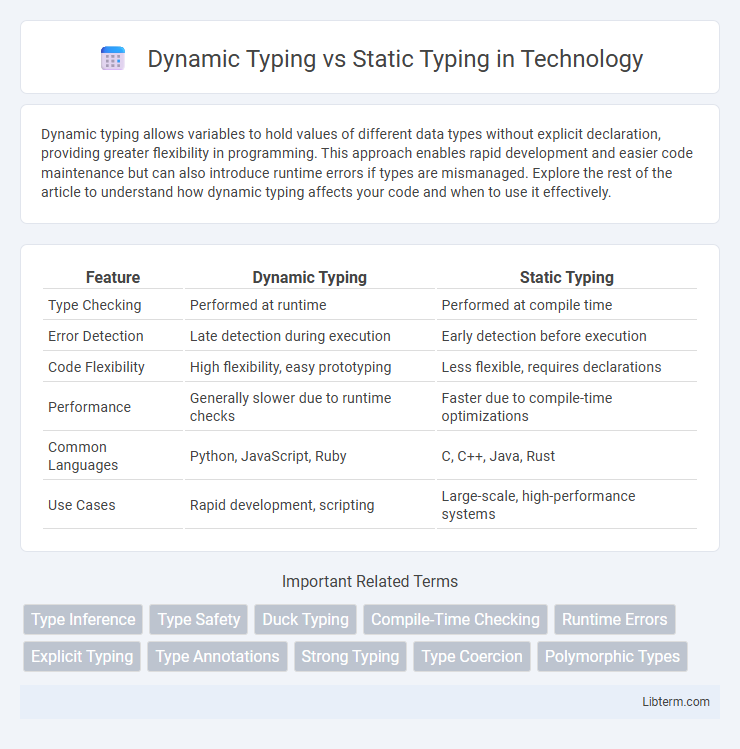Dynamic typing allows variables to hold values of different data types without explicit declaration, providing greater flexibility in programming. This approach enables rapid development and easier code maintenance but can also introduce runtime errors if types are mismanaged. Explore the rest of the article to understand how dynamic typing affects your code and when to use it effectively.
Table of Comparison
| Feature | Dynamic Typing | Static Typing |
|---|---|---|
| Type Checking | Performed at runtime | Performed at compile time |
| Error Detection | Late detection during execution | Early detection before execution |
| Code Flexibility | High flexibility, easy prototyping | Less flexible, requires declarations |
| Performance | Generally slower due to runtime checks | Faster due to compile-time optimizations |
| Common Languages | Python, JavaScript, Ruby | C, C++, Java, Rust |
| Use Cases | Rapid development, scripting | Large-scale, high-performance systems |
Introduction to Typing Systems
Typing systems classify programming languages based on how they enforce data type constraints, with static typing checking types at compile-time and dynamic typing performing checks at runtime. Static typing enables early error detection and improved performance by validating type consistency before execution, while dynamic typing offers greater flexibility and faster prototyping through runtime type evaluation. Understanding the distinctions between dynamic and static typing is essential for selecting the appropriate language paradigm to balance safety, efficiency, and development speed.
What is Static Typing?
Static typing is a programming language feature where variable types are explicitly declared and checked at compile time, preventing type errors before the code runs. Languages like Java, C++, and Rust enforce static typing to enhance code reliability, readability, and performance by catching mismatches early. This approach allows for improved tooling support, such as autocomplete and refactoring capabilities, by leveraging type information during development.
What is Dynamic Typing?
Dynamic typing is a type system where variable types are determined at runtime rather than at compile time, allowing for more flexibility in code. Languages like Python, JavaScript, and Ruby use dynamic typing, which enables developers to write code without explicitly declaring variable types. This approach enhances rapid prototyping and ease of use but can lead to type-related runtime errors if not carefully managed.
Key Differences Between Static and Dynamic Typing
Static typing enforces type checking at compile-time, ensuring type safety by catching errors before execution, whereas dynamic typing performs type checking at runtime, allowing more flexibility but increasing the risk of type-related errors during execution. Static typing often results in faster performance and improved code maintainability due to explicit type declarations, while dynamic typing enables rapid development and ease of code modification without requiring type annotations. Key differences include error detection timing, code verbosity, runtime efficiency, and suitability for large-scale versus small-scale or prototype projects.
Advantages of Static Typing
Static typing enhances code reliability by catching type errors at compile time, reducing runtime exceptions and debugging efforts. It improves code readability and maintainability through explicit type declarations, facilitating better tooling support such as autocomplete and refactoring in integrated development environments (IDEs). Static typing also enables more efficient performance optimizations since the compiler has precise type information during code generation.
Advantages of Dynamic Typing
Dynamic typing offers greater flexibility by allowing variables to hold any data type without explicit declarations, resulting in faster development cycles and easier code modifications. It enhances rapid prototyping and experimentation since type enforcement occurs at runtime, reducing initial coding overhead. Dynamic typing also supports polymorphism naturally, enabling more adaptable and concise code in languages like Python and JavaScript.
Common Languages Using Static and Dynamic Typing
Dynamic typing is employed by languages such as Python, JavaScript, and Ruby, allowing variables to hold values of any type without explicit type declarations, which facilitates rapid prototyping and flexibility. Static typing is a feature of languages like Java, C++, and Rust, where variable types are explicitly declared and checked at compile time, enhancing performance, early error detection, and code maintainability. Languages like TypeScript blend static typing with JavaScript's dynamic nature to provide type safety while retaining flexibility.
Performance and Error Handling Comparison
Dynamic typing allows variables to hold any data type at runtime, which can reduce performance due to type checking during execution, whereas static typing enforces data types at compile time, resulting in faster code execution and early error detection. Static typing provides robust error handling by catching type-related errors before the program runs, reducing runtime exceptions common in dynamically typed languages. Performance benchmarks typically show statically typed languages like C++ or Rust outperforming dynamically typed languages such as Python or JavaScript, especially in large-scale applications where type safety and execution speed are critical.
Use Cases: When to Choose Static or Dynamic Typing
Static typing is ideal for large-scale software projects requiring early error detection, enhanced code maintainability, and improved performance, commonly seen in enterprise applications and systems programming. Dynamic typing suits rapid prototyping, scripting, and web development where flexibility and quick iterations are critical, such as in startups and small team environments. Choosing static typing benefits scenarios needing robust type safety and predictable behavior, while dynamic typing excels in projects demanding agility and ease of code modification.
Conclusion: Which Typing System is Right for You?
Choosing between dynamic typing and static typing depends on your project requirements and development priorities. Dynamic typing offers flexibility and faster prototyping, ideal for startups and scripting tasks, while static typing provides early error detection and better maintainability, suited for large-scale and mission-critical applications. Assessing factors like team expertise, project complexity, and debugging needs will guide you to the typing system that optimally balances productivity and reliability.
Dynamic Typing Infographic

 libterm.com
libterm.com